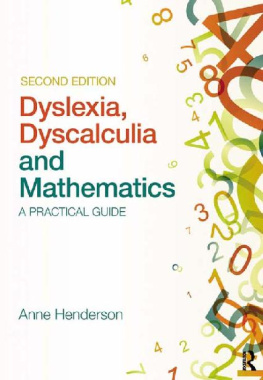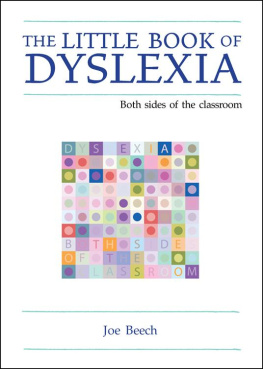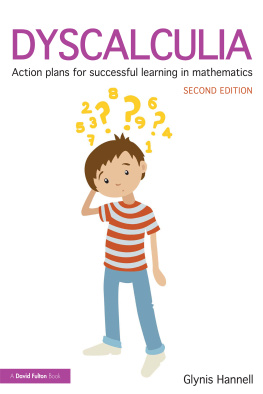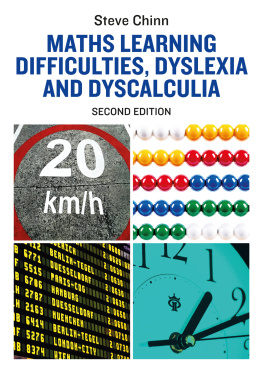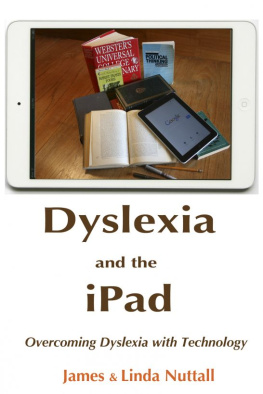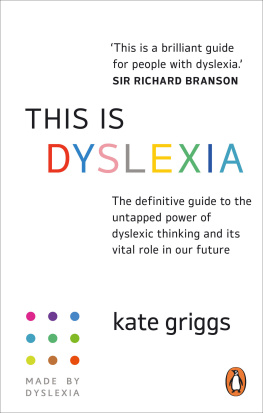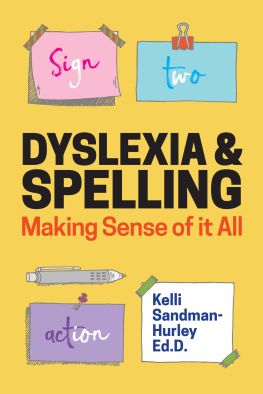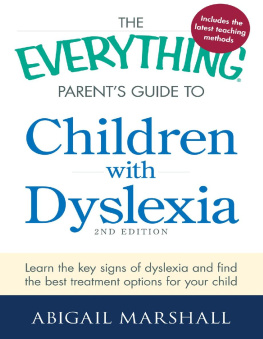Dyslexia, Dyscalculia and Mathematics
Dyslexia, Dyscalculia and Mathematics will be an essential resource for teachers, classroom assistants and special educational needs co-ordinators (SENCOs) who help dyslexic and dyscalculic children with their understanding of mathematics. Written in an accessible style with helpful illustrations, this practical book reveals helpful ways in which to tackle both simple and complex concepts with students of all ages.
This second edition has been updated to include references to using technology that will help children with dyslexia and dyscalculia reinforce their mathematical skills, and also contains a number of photocopiable resources that can be used in the classroom. Written by Anne Henderson, who is experienced in teaching language and mathematics to pupils with dyslexia and dyscalculia, this book outlines current thinking in the field and shows how the research methods that have been proven successful can be used with whole classes of children.
This book encourages flexible methods and gives teachers the confidence to discuss alternative solutions with their pupils and help them achieve success. It is an ideal handbook for parentteacher programmes and is also suitable for in-service training.
Anne Henderson is a lecturer in Mathematics and Dyslexia for Masters and Diploma courses at UCW Bangor, Wales, as well as Educational Consultant for BEAM mathematics and Numicon. She has provided training all over the world.
For my lovely grandchildren,
Callum, Ross, Euan, Ffion, Haf and Leo
Dyslexia, Dyscalculia
and Mathematics
A practical guide
Second edition
Anne Henderson

First edition published as Maths for the Dyslexic
by David Fulton Publishers 1998
This edition published 2012
by Routledge
2 Park Square, Milton Park, Abingdon, Oxon OX14 4RN
Simultaneously published in the USA and Canada
by Routledge
711 Third Avenue, New York, NY 10017
Routledge is an imprint of the Taylor & Francis Group, an informa business
2012 Anne Henderson
The right of Anne Henderson to be identified as author of this work has been asserted by her in accordance with sections 77 and 78 of the Copyright, Designs and Patents Act 1988.
All rights reserved. The purchase of this copyright material confers the right on the purchasing institution to photocopy pages which bear the photocopy icon and copyright line at the bottom of the page. No other parts of this book may be reprinted or reproduced or utilised in any form or by any electronic, mechanical, or other means, now known or hereafter invented, including photocopying and recording, or in any information storage or retrieval system, without permission in writing from the publishers.
Trademark notice: Product or corporate names may be trademarks or registered trademarks, and are used only for identification and explanation without intent to infringe.
British Library Cataloguing in Publication Data
A catalogue record for this book is available from the British Library
Library of Congress Cataloging in Publication Data
A catalog record for this book has been requested
ISBN: 978-0-415-68311-1 (pbk)
ISBN: 978-0-203-80388-2 (ebk)
Typeset in Helvetica
by Saxon Graphics Ltd, Derby
Contents
I would like to thank my daughter Bethan, a health psychologist who, even in the middle of a further doctorate to become a clinical psychologist, has found time to share her knowledge and expertise, and my dyslexic son Gareth, a consultant petrophysicist who from distant Kazakhstan has helped so very much. Both of them gave me encouragement to complete this project. Thanks also to my sister Vera, her daughter Davina Perry and my friend Ann Harrison, who are all teachers leading busy lives, but have found time to discuss their experiences about numeracy so willingly.
I also thank Nicky Silcocks, Suzanne Keith, Margaret Haseler, Silke Vanatter, Lee Khiang Kong, Lee Chew Ing, Melody Appleton, Tony Wing, Gwynfor Parry, Nick Dowrick, Yvonne Panteli, Jean Robertson, Romey Tacon, Ruth Atkinson, Penny Manning and her team (Hayley Roberts, Natalie Hough, Jo Bain, Hilary Glover, Katherine Sinclair, Karen Strowbridge, Natalie Goodwin, Ruth Ashworth and Samantha Joy), whose views changed and directed the course of the script.
A special thanks to Ann Cooke and the Miles Dyslexia Centre, Bangor University, for allowing me over the years to work with so many interesting and gifted students.
I wish to thank Edge Hill University for permission to include details of the Numbers Count Intervention Strategy also Oxford University Press for their permission to include details of the Numicon programme. Images of Numicon materials on pages 4850 are reproduced with kind permission of Oxford University Press, Numicon Oxford University Press 2010.
In the fourteen years since the frist edition of this book the knowledge of the mathematical difficulties of dyslexic and dyscalculic children has grown considerably. Research on various numerical skills has increased as neuroscientists using brain scans have identified differences between the so-called normal brain and those of the dyslexic and dyscalculic. This evidence provides proof that some children struggle to compensate for a physical difference, so therefore the majority of teachers will be reluctant to describe a child as lazy or not trying when obviously the child is struggling with a physical difficulty.
In addition, my own experiences working, providing training and lecturing throughout the United Kingdom and many countries around the world (Australia, Brazil, Chile, Ireland, North America, Korea, New Zealand, Luxembourg, Spain, Malaysia, Singapore and Hong Kong) have given me a greater insight into these difficulties. Talking and working with teachers and educationalists showed me clearly that it is impossible to ignore the importance of the early years, and it is for this reason I have included a section on early numeracy skills in this book.
Although I was a teacher of mathematics, I spent ten years teaching dyslexic children of all ages with literacy difficulties, familiarizing myself with ways to help them spell, read and write. This was an excellent experience but a steep learning curve for me. I was aware that these children had a hidden handicap which magnified the problem, because it is always easier to be more understanding if a child has a visible handicap, perhaps in a wheelchair or a broken arm, than if they have one that cannot be seen. As I became confident in my own ability to help these children, I moved on to helping dyslexic/dyscalculic children at primary level to acquire basic number skills. This initial teaching experience in such a specialist field enabled me subsequently to work for many years with older dyslexic and dyscalculic students in a secondary setting, and eventually with supporting adults in the workplace.
I learned alongside my students which strategies worked, thus increasing my own knowledge of the difficulties that both younger and older dyslexic and dyscalculic children face in mathematics. In time, I realised that all the skills I had acquired in helping students with literacy problems, consolidating basics, multi-sensory teaching, improving visualisation skills, looking at learning styles and building on strengths, were just the skills needed to help them in mathematics.
Based on these intervention strategies I have provided photocopiable memory cards, the size of credit cards, in the Appendix. These may be copied onto card, cut out and placed into a credit card wallet. These cards can be personalised by encouraging children to draw, colour, or write something specific to them on the reverse of the card to help them remember the information the card has provided. Children of all ages have found these memory cards invaluable as they are easy to carry and simple to use as memory joggers.

